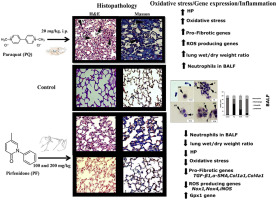Food and Chemical Toxicology ( IF 3.9 ) Pub Date : 2017-12-19 , DOI: 10.1016/j.fct.2017.12.034 Fateme Pourgholamhossein , Rokhsana Rasooli , Mostafa Pournamdari , Leyla Pourgholi , Mitra Samareh-Fekri , Mahmoud Ghazi-Khansari , Maryam Iranpour , Hamid-Reza Poursalehi , Mahmoud-Reza Heidari , Ali Mandegary

|
In this study we investigated the protective effects and possible mechanisms of pirfenidone (PF) in paraquat (PQ)-induced lung injury and fibrosis in mice. Lung injury was induced by injection of PQ (20 mg/kg). Thereafter, mice orally received water and PF (100 and 200 mg/kg) for four weeks. After 28 days, the inflammation and fibrosis were determined in the lungs by analysis of histopathology, bronchoalveolar lavage fluid (BALF) cell count, lung wet/dry weight ratio, hydroxyproline content, and oxidative stress biomarkers. Expression of several genes involved in fibrogenesis and modulation of reactive oxygen species (ROS) production, such as TGF-β1, α-SMA, collagen Iα and IV, NOX1, NOX4, iNOS, and GPX1 were determined using RT-qPCR. PF significantly decreased the lung fibrosis and edema, inflammatory cells infiltration, TGF-β1 concentration, and amount of hydroxyproline in the lung tissue. PF dose-dependently improved the expression level of the studied genes to the near normal. Decreasing of lung lipid peroxidation and catalase activity, and increasing of SOD activity in the treated mice were significant compared to the control group. Pirfenidone ameliorate paraquat induced lung injury and fibrosis partly through inhibition of inflammation and oxidative stress, and downregulation of genes encoding for profibrotic cytokines and enzymatic systems for ROS production.
中文翻译:

吡非尼酮可通过调节炎症,氧化应激和基因表达来防止百草枯引起的小鼠肺损伤和纤维化
在这项研究中,我们研究了吡非尼酮(PF)在百草枯(PQ)诱导的小鼠肺损伤和纤维化中的保护作用及其可能的机制。注射PQ(20 mg / kg)引起肺损伤。此后,小鼠口服接受水和PF(100和200 mg / kg)四个星期。28天后,通过组织病理学,支气管肺泡灌洗液(BALF)细胞计数,肺干/湿重比,羟脯氨酸含量和氧化应激生物标记物的分析确定了肺部的炎症和纤维化。使用RT-qPCR确定了涉及纤维发生和活性氧(ROS)产生调节的几种基因的表达,例如TGF-β1,α-SMA,胶原Iα和IV,NOX1,NOX4,iNOS和GPX1。PF明显降低了肺纤维化和水肿,炎性细胞浸润,TGF-β1浓度,和肺组织中羟脯氨酸的量。PF剂量依赖性地将所研究基因的表达水平提高至接近正常水平。与对照组相比,治疗小鼠的肺脂质过氧化和过氧化氢酶活性降低,SOD活性升高。吡非尼酮部分地通过抑制炎症和氧化应激以及下调编码纤维化细胞因子的基因和产生ROS的酶系统来改善百草枯引起的肺损伤和纤维化。











































 京公网安备 11010802027423号
京公网安备 11010802027423号